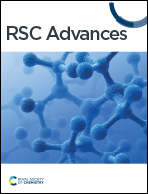Accelerated synthesis of 1,8-dioxo-octahydroxanthene and 1,8-dioxo-decahydroacridine derivatives using dendritic mesoporous nanosilica functionalized by hexamethylenetetramine: a novel nanocatalyst
Abstract
Xanthene and acridine derivatives are interesting organic compounds that are used in different research fields like biomedicine and pharmaceutical science. However, applied catalysts for their synthesis have some limitations such as long reaction times, the need for harsh conditions and low yield. So, discovery of novel catalysts for the synthesis of xanthene and acridine derivatives is highly demanded. To overcome the limitation of previous methods on the efficient synthesis of 1,8-dioxo-octahydroxanthene and 1,8-dioxo-decahydroacridine derivatives, a green heterogeneous organic nano-catalyst (Cu@KCC-1–nPr–HMTA) was synthesized by covalent attachment of hexamethylenetetramine to the cavities and channels of dendritic mesoporous nanosilica (KCC-1). The prepared nano-catalyst was identified using various spectroscopic and microscopic methods including scanning electron microscopy (SEM), Fourier transform infrared (FT-IR), X-ray energy diffraction (EDX), EDX mapping and nitrogen adsorption–desorption analysis (BET-BJH). The prepared green nano-catalyst showed a spherical and dendritic structure with a surface area of 65.699 m2 g−1, average pore size of 40.78 nm and pore volume of 0.66 cm3 g−1. Also, Cu@KCC-1–nPr–HMTA has many chemo-active sites for the condensation reaction and was used as an efficient nano-catalyst towards one-step synthesis of 1,8-dioxo-decahydroacridine and 1,8-dioxo-octahydroxanthene derivatives from the reaction of aromatic aldehydes, dimedone, and ammonium acetate under solvent-free conditions. Short reaction times of 1 to 5 minutes for 1,8-dioxo-decahydroacridine and 30 to 55 minutes for 1,8-dioxo-octahydroxanthene derivatives, high yields and mild reaction conditions are advantages of the proposed synthetic method. It is hoped that the engineered nano-catalyst will be used for the synthesis of other organic compounds in the future.



 Please wait while we load your content...
Please wait while we load your content...